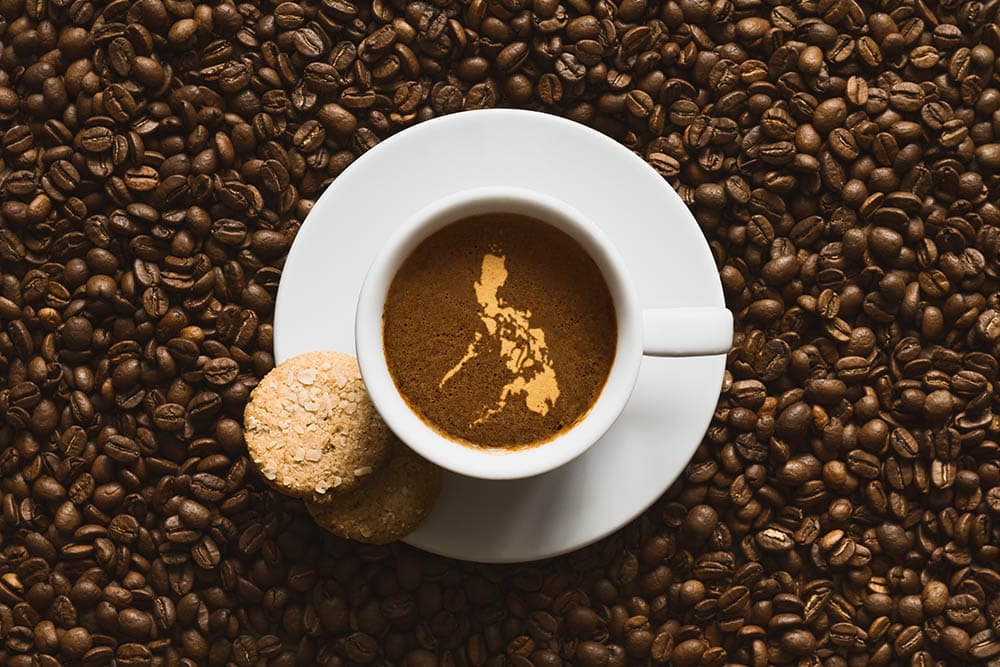
The Philippines is not well-known for producing coffee, often overlooked in favor of coffee giants like Brazil, Ethiopia, and Colombia. Few people realize that The Philippines has been producing coffee for close to 200 years and was even the world’s number one coffee producer during the late 18th century.
In this article, we are going to give Philippine coffee its due by introducing you to the history of coffee in the Philippines and providing a brief overview of modern Philippine coffee. We’ll cover geography and climate, what varieties are produced, and where to pick up Philippine coffee if you want to give it a try. Let’s get started.

A Short Philippine Coffee History Lesson
Coffee growing began in the Philippines during the middle of the 18th century but took center stage in the 1880s due to a global coffee blight. Coffee rust — a fungal disease that reduces coffee tree yields and often leads to their death — hit the world’s foremost coffee-producing countries, leaving The Philippines to pick up the slack. As a result, for several years, The Philippines was the number one coffee-producing country in the world. Eventually, coffee rust made its way to The Philippines, stopping their coffee production in its tracks.
Although the Philippines’ reign as coffee king was cut short, it proved that the country could produce coffee at scale, begging the question: what happened?

The answer is complicated, involving many ecological and political factors, but the main answer is that the country is simply too small to compete with larger countries with more farmable land. The Philippines’ climate is well-suited for coffee production, having the right combination of humidity, sunshine, and rainfall. However, it lacks other factors, most notably swaths of high-altitude farmable land, limiting the volumes of specialty coffee that can be grown there.
The Philippines also suffers from violent typhoons that can decimate coffee crops if they hit at the wrong time. Most coffee-producing countries must grapple with Mother Nature to some extent, but the island environment in the Philippines is especially turbulent.
Throughout its history, The Philippines has been an importer of coffee, relying on other countries like Vietnam to meet their coffee demand. In 1960, the Philippine government passed a law prohibiting coffee importation in an attempt to stimulate the domestic coffee industry. It worked for a while but ultimately failed when the International Coffee Agreement failed in 1989.

The State of the Philippine Coffee Industry
Today, the Philippine coffee industry lags behind the rest of the world when it comes to the modern specialty coffee movement. The majority of coffee consumed in The Philippines comes from other countries like Vietnam and Indonesia. The comparatively small scale of the Philippines’ coffee industry means Philippine coffee is more expensive and of lower quality than its competitors. In a catch-22 scenario, Philippine coffee producers can’t afford to take the necessary steps to improve their coffee because the demand for Philippine coffee is low due to its bad reputation.
The issue is largely one of infrastructure. Quality control and consistency are often missing from Philippine coffee, and farmers are not incentivized to improve these aspects of their production since they won’t be able to recoup their investment by charging higher prices.
The Philippine Coffee Industry Roadmap for 2017–2022 was introduced in early 2017 to set a course for improving the domestic coffee industry in the Philippines. With a well-thought-out plan and backing from private institutions like the Philippine Coffee Board, the hope is that Philippine coffee will become more competitive on the world stage soon.
Varieties and Where to Buy Philippine Coffee
The Philippines is an enormous collection of more than 7,000 individual islands, giving coffee from the Philippines a wide range of characteristics depending on where it was grown. Expert tasters and coffee competition judges often describe Philippine coffee to those who haven’t tried it themselves as a unique blend of African and Indonesian flavor profiles.
Philippine Coffee Company — not The Philippine Coffee Company — is one of the best places to buy Philippine Coffee if you’re outside the country. They sell 100% Philippine coffee and have a rotating selection of beans that span all the major varieties produced in the Philippines.
We recommend starting with a washed, single-origin Kape Arabica to get a sense of how the most by-the-book Philippine coffee tastes. Once you establish a baseline, then you can branch out into wet-processed coffees and other more interesting options.
Because of the wide range of styles and flavor profiles of Philippine coffee, it is impossible to recommend one brewing method as the best option. Instead, we recommend using your favorite brewing method and comparing the flavors and characteristics to the coffee you’re used to.

Conclusion
Thanks to failed legislation and ecological struggles, the Philippines has flown under the radar for most of its coffee-producing history. Despite its rocky history, there is cause for optimism for the future of Philippine coffee. Local governments and private businesses combine their effort to jumpstart the Philippine coffee industry and boost the quality and scale of coffee production. Only time will tell if the efforts are successful, but the future looks bright for Philippine coffee.
Read More:
- Coffee Shops in the Philippines: 12 Statistics to Know
- Singapore Coffee: History, Flavors & Ordering Tips
- Australian Coffee: History, Brewing Tips, & Flavors
Featured Image Credit: PatrikV, Shutterstock















